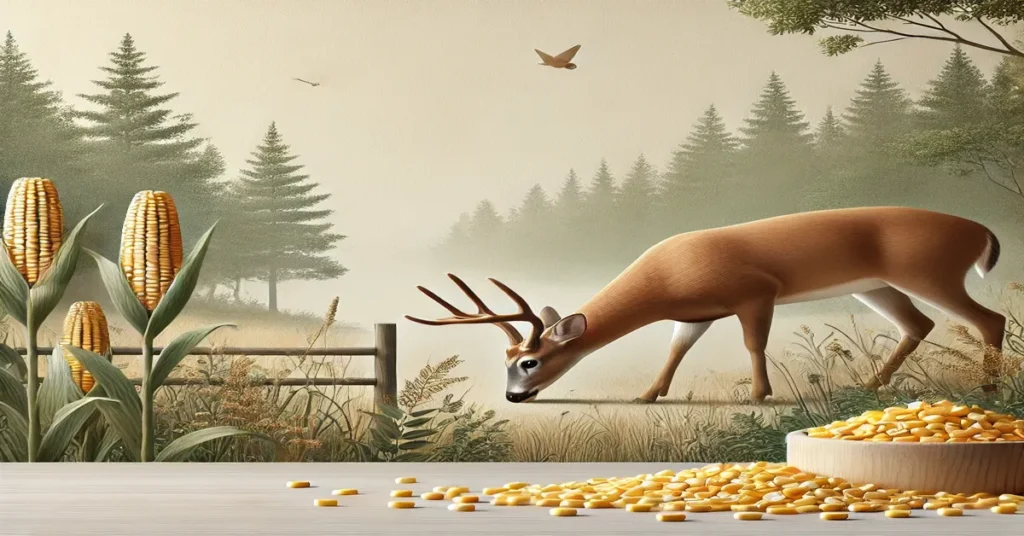Deer corn has become an essential staple for hunters, wildlife enthusiasts, and deer farmers who want to attract, feed, and observe deer populations. Widely used across North America, deer corn’s is specifically processed and designed to meet the dietary and energy needs of deer, making it a convenient, affordable, and effective feed option. However, like any form of supplemental feeding, it has both benefits and limitations. In this article, we’ll explore what deer corn’s is, how it’s used, its nutritional value, the ecological considerations, and the proper way to integrate it into a wildlife management plan.
Table of Contents
- What is Deer Corn?
- Nutritional Value of Deer Corn‘s
- Why Deer Are Attracted to Corn
- Types of Deer Corn’s Available
- The Role of Deer Corn’s in Hunting
- Using Deer Corn’s for Supplemental Feeding
- Ecological Considerations and Risks
- Proper Feeding Practices
- Alternative Feeds for Deer
- Conclusion
- FAQs
1. What is Deer Corn?
Deer corn’s is a specific type of corn used as supplemental feed for deer populations. While it’s not drastically different from regular field corn, deer corn’s is often cleaned and processed to make it more digestible and appealing to deer. It is primarily used in hunting, deer farming, and wildlife observation. Deer corn’s is typically available in bags of various sizes and is easy to distribute in feeders, on the ground, or within food plots.
Deer corn’s is often classified by its consistency, quality, and the absence of contaminants, which are crucial when feeding wildlife to prevent any adverse health effects.
2. Nutritional Value of Deer Corn
Deer corn’s is rich in carbohydrates, which provide the energy deer need to survive, especially during colder months. Here’s a general nutritional breakdown:
- Carbohydrates: The primary energy source in corn, providing quick energy for deer.
- Protein: Corn has a relatively low protein content, around 7-10%. However, deer require a diet higher in protein (15-20%) for optimal health and antler growth, especially during summer and early fall.
- Fiber: Corn is low in fiber, making it easier for deer to digest compared to other forage sources.
- Fats: Small amounts of fat (around 4-5%) contribute to the overall caloric intake.
While deer corn’s provides high energy levels, it lacks essential nutrients like proteins, minerals, and vitamins. Therefore, it should be used as part of a diverse feeding strategy rather than as the sole feed source.
3. Why Deer Are Attracted to Corn
Deer are naturally attracted to corn due to its taste, texture, and high carbohydrate content. Corn is sweet and crunchy, which is appealing to deer, especially when natural food sources are scarce. It also has a distinct scent that draws deer from considerable distances, making it a popular choice for hunters and wildlife enthusiasts looking to attract deer to a specific area.
During fall and winter, when natural food sources are limited, deer seek out high-energy foods to maintain body weight and warmth. Corn, with its dense carbohydrate content, serves as an ideal supplement in these situations.
4. Types of Deer Corn Available
There are several types of deer corn’s available, each catering to different needs and preferences. Here are some common types:
- Whole Kernel Corn: This is the most popular form, consisting of whole, cleaned kernels that deer can easily digest and consume.
- Cracked Corn: Cracked corn is broken down into smaller pieces, making it easier for young deer and other small animals to consume.
- Flavored Corn: Some manufacturers offer flavored deer corn’s, infused with apple or acorn scents to make it even more attractive to deer.
- Fortified Corn: This type of deer corn’s is enriched with minerals and vitamins to enhance its nutritional profile, making it a better option for long-term feeding.
5. The Role of Deer Corn in Hunting
Deer corn’s is a crucial tool in hunting for attracting deer to specific locations, allowing hunters to study deer movements and anticipate patterns. Hunters often use corn feeders or spread corn in bait piles to bring deer closer to their hunting blinds or tree stands.
However, using corn for bait is regulated in many areas, and hunters must comply with local laws regarding baiting. In some states, baiting is strictly prohibited, while others allow it under certain conditions. Therefore, it’s essential to research local regulations before incorporating deer corn’s into a hunting strategy.
6. Using Deer Corn for Supplemental Feeding
Supplemental feeding of deer, particularly during harsh winters, has been practiced for decades. Deer corn’s can be part of a larger feeding program, providing deer with additional calories when natural forage is scarce. Here are some key benefits:
- Winter Survival: In cold climates, deer corn’s offers the calories deer need to stay warm and maintain body weight.
- Observation and Management: Deer corn’s attracts deer to specific locations, enabling wildlife managers and enthusiasts to observe and study populations more closely.
- Support for Young and Pregnant Deer: High-energy corn can help fawns and pregnant does during challenging seasons, improving overall survival rates.
Despite these benefits, it’s crucial to approach supplemental feeding with caution to avoid dependency and health issues.
7. Ecological Considerations and Risks
While deer corn’s can be beneficial, it also presents some ecological concerns:
- Nutritional Deficiency: Corn lacks the protein, fiber, and minerals deer need for balanced nutrition. Over-reliance on corn can lead to nutritional deficiencies, particularly during periods of growth and antler development.
- Health Risks: Corn can cause digestive issues, such as acidosis, if consumed in large amounts. Acidosis occurs when too much carbohydrate-rich feed is consumed, causing the stomach’s pH level to drop, which can lead to bloating and even death.
- Altered Feeding Patterns: Feeding corn in large amounts may alter deer’s natural foraging behavior, making them reliant on supplemental food. This reliance can impact natural habitats and reduce deer’s adaptability to seasonal changes.
- Disease Transmission: Feeding stations can increase the risk of disease transmission among deer populations due to close contact and contamination.
8. Proper Feeding Practices
If you choose to use deer corn’s for supplemental feeding, it’s essential to follow best practices to avoid negative impacts on deer health:
- Use Corn Sparingly: Rather than providing large quantities of corn, use it sparingly and combine it with other feeds like alfalfa, soybeans, and mineral supplements.
- Rotate Feeding Locations: Moving feeding locations can help prevent overgrazing and reduce the risk of disease transmission.
- Introduce Gradually: When feeding deer corn’s, especially in winter, introduce it gradually to allow deer’s digestive systems to adapt. Sudden changes in diet can be harmful.
- Avoid Moldy Corn: Always check for mold in deer corn’s, as moldy corn can be toxic to deer. Store corn in a dry, cool place to prevent contamination.
9. Alternative Feeds for Deer
While corn is widely used, there are alternatives that provide better nutritional balance:
- Alfalfa: Rich in protein, fiber, and vitamins, alfalfa is an excellent supplement to deer corn’s, especially during spring and summer.
- Soybeans: High in protein and fat, soybeans are ideal for deer during the rutting season and winter months.
- Commercial Deer Pellets: These pellets are designed to meet the nutritional needs of deer, providing a balanced blend of protein, fiber, minerals, and vitamins.
- Natural Food Plots: Planting natural food plots with a mix of clover, brassicas, and legumes can provide deer with diverse, nutritious forage year-round.
Conclusion
Deer corn’s is a valuable tool for hunters, wildlife enthusiasts, and conservationists. It serves as a quick-energy food source for deer, especially during times when natural food is scarce. However, it should not be the sole feed source due to its lack of balanced nutrition and potential health risks. When used responsibly and in moderation, deer corn’s can enhance deer management and support deer populations in challenging seasons.
FAQs
1. Is deer corn safe for deer to eat?
Yes, deer corn is safe in moderation, but it should not be the primary food source as it lacks essential nutrients.
2. Can feeding deer corn attract other animals?
Yes, deer corn’s can attract various animals like raccoons, squirrels, and birds, as well as larger animals like bears in certain regions.
3. Is it legal to use deer corn for hunting?
It depends on local hunting regulations. Some states allow baiting, while others restrict or prohibit it. Always check local laws.
4. How often should I feed deer corn?
Feeding deer corn’s should be done sparingly, ideally as part of a balanced feeding plan that includes other sources of nutrition.
5. Can corn harm deer?
Overconsumption of corn can cause acidosis, a digestive disorder. To avoid this, limit the quantity and frequency of corn feeding.
6. What are some alternative feeds to deer corn?
Alternatives include alfalfa, soybeans, commercial deer pellets, and natural food plots for a more balanced diet.







